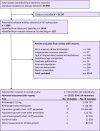When is birthweight at term abnormally low? A systematic review and meta-analysis of the association and predictive ability of current birthweight standards for neonatal outcomes
- PMID: 24397731
- PMCID: PMC4162997
- DOI: 10.1111/1471-0528.12517
When is birthweight at term abnormally low? A systematic review and meta-analysis of the association and predictive ability of current birthweight standards for neonatal outcomes
Abstract
Background: Intrauterine growth restriction is a cause of neonatal morbidity and mortality. A variety of definitions of low birthweight are used in clinical practice, with a lack of consensus regarding which definitions best predict adverse outcomes.
Objectives: To evaluate the relationship between birthweight standards and neonatal outcome in term-born infants (at ≥ 37 weeks of gestation).
Search strategy: MEDLINE (1966-January 2011), EMBASE (1980-January 2011), and the Cochrane Library (2011:1) and MEDION were included in our search.
Selection criteria: Studies comprising live term-born infants (gestation ≥ 37 completed weeks), with weight or other anthropometric measurements recorded at birth along with neonatal outcomes.
Data collection and analysis: Data were extracted to populate 2 × 2 tables relating birthweight standard with outcome, and meta-analysis was performed where possible.
Main results: Twenty-nine studies including 21 034 114 neonates were selected. Absolute birthweight was strongly associated with mortality, with birthweight < 1.5 kg giving the largest association (OR 48.6, 95% CI 28.62-82.53). When using centile charts, regardless of threshold, the summary odds ratios were significant but closer to 1 than when using absolute birthweight. For all tests, summary predictive ability comprised high specificity and positive likelihood ratio for neonatal death, but low sensitivity and a negative likelihood ratio close to 1.
Author's conclusions: Absolute birthweight is a prognostic factor for neonatal mortality. The indirect evidence suggests that centile charts or other definitions of low birthweight are not as strongly associated with mortality as the absolute birthweight. Further research is required to improve predictive accuracy.
Keywords: Fetal growth restriction; low birthweight; neonatal morbidity; neonatal mortality; systematic review.
© 2014 The Authors BJOG An International Journal of Obstetrics and Gynaecology published by John Wiley & Sons Ltd on behalf of Royal College of Obstetricians and Gynaecologists.
Figures



References
-
- Center for Maternal and Child Enquiries (CMACE) Perinatal Mortality 2009: United Kingdom. London: CMACE; 2011.
-
- Bernstein IM, Horbar JD, Badger GJ, Ohlsson A, Golan L. Morbidity and mortality among very-low-birth-weight neonates with intrauterine growth restriction. Am J Obstetr Gynecol. 2000;182:198–206. - PubMed
-
- Brodsky D, Christou H, Brodsky D, Christou H. Current concepts in intrauterine growth restriction. J Intensive Care Med. 2004;19:307–19. - PubMed
-
- Bukowski R. Fetal growth potential and pregnancy outcome. Semin Perinatol. 2004;28:51–8. - PubMed
-
- Eichenwald EC, Stark AR, Eichenwald EC, Stark AR. Management and outcomes of very low birth weight. N Engl J Med. 2008;358:1700–11. - PubMed
Publication types
MeSH terms
Grants and funding
LinkOut - more resources
Full Text Sources
Other Literature Sources
Medical

